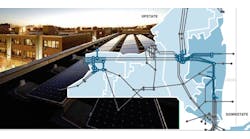A virtual power plant works remotely to combine a number of independent energy resources from disparate locations into a network that provides reliable power 24 hours a day.
A departure from centralized plants
The concept of virtual power plants turns on its head the more traditional idea of relying on centralized power plants for predictable power. Generally, the US has depended on controllable power from big, centralized plants, often coal or natural gas plants. Power flow has been in one direction — from the utility to the business or consumer.
But in recent years, small and large independent power producers have entered the scene, generating solar, wind and other renewable resources from all corners of the US. Suddenly, power flow has become bidirectional. This clean power has disrupted the energy grid and created a need for new models.
How DER has sparked a need for the virtual power plant
In many ways, the virtual power plant is a product of the fact that more and more DERs are making their way to the grid. The distributed energy has created challenges for grid operators. At its worst, oversupply of renewable resources can spark power outages. Abundant supplies of distributed clean energy have created challenges in Hawaii, Arizona, the Pacific Northwest, Texas and California, and other regions internationally. High volumes of distributed resources also create reverse power flows that create technical challenges and network congestion.
Often, oversupplies mean that utilities and grid operators have to deal with supply variability by turning to dirty, fossil fuel-based power plants. For example, they call on these more conventional resources to cope with sudden drops of solar supplies when the sun starts to set, creating a spike in demand.
But virtual power plant proponents argue that this supply balancing can be done with less expensive, less polluting, virtual power plants based on clean power. As “virtual” plants capable of providing power 24 hours a day, they can serve as a substitute for fossil fuel-fired plants.
Obstacles to virtual power plants
In spite of the virtual power plant’s virtues, a number of obstacles make it difficult to bring them online. Some worry that they’re vulnerable to cyberattacks. Another concern is that high levels of distributed energy resources can affect local voltage, unless a voltage control scheme is in place. And a third obstacle is regulatory; incentives are needed to help virtual power plant operators bring their benefits to the system.
The world’s largest behind-the-meter virtual power plant is being developed in Japan.
When virtual power plants overcome such obstacles, they can provide ancillary services to respond to imbalances created by renewable energy and other intermittent resources or failures of large power plants.
If an imbalance occurs, the transmission system operator might call on a virtual power plant to quickly boost or decrease output, often in real time. For example, in Germany, a network of more than 1,000 biogas, solar, wind and water plants are located across four of Germany’s transmission grids. Together, as a virtual power plant, these resources provide up to 796 MW of clean energy that boosts grid stability.
Virtual power plants also can provide demand response automatically, eliminating the need for day-ahead planning. They can respond immediately to price signals, shifting commercial and residential loads or aggregating other distributed energy resources.
In addition, they can provide load shedding, capacity relief and frequency regulation.
Virtual power plant vs. microgrid
Like virtual power plants, microgrids aggregate and optimize distributed energy resources. However, microgrids have a very defined network boundary and a very specific area that benefits their owners. What’s more, they can disconnect from the main grid to act as islands of power. Virtual power plants, on the other hand, often cover a wider area and are flexible enough to expand or contract the area in which they operate, depending on market conditions. They serve the main grid, while microgrids don’t always provide services to the main grid.
The virtual power plant in action
The Australian Energy Market Commission was one of the early regulatory bodies to put the idea of virtual power plants into practice when it ruled that virtual power plants can compete freely in the country’s wholesale electricity market.
The decision was expected to encourage new players to aggregate solar and battery storage in homes and businesses.
The Australian Renewable Energy Agency provided $7.7 million to build a virtual power plant with Tesla Powerwalls in up to 1,200 Adelaide homes.
The customers will reap lower costs because the battery systems will allow them to store and take advantage of more rooftop solar and see lower power costs. And the battery systems provide backup power in the event of an outage.
The three-year trial will give South Australia Power Networks (SAPN) greater visibility into behind-the-meter battery storage. SAPN will also be able to use the batteries as DERs that can address local network constraints and manage demand.
But Australia is not alone. Virtual power plants are taking off in other parts of the world as well.
In Europe, a mega virtual power plant networks more than 5,000 energy-producing and energy-consuming units with a total capacity of over 4,100 MW. The concept is also drawing in major European energy developers and technology companies.
In the US, Vermont’s Green Mountain Power created a virtual power plant with 500 batteries in homes to address peak demand, yielding $500,000 in savings in one 1-hour peak demand period.
In Michigan, Consumers Energy has proposed using virtual power plants to reduce energy demand 22% by 2040, a necessity as it fossil fuel generation plants.
In California, the virtual power plant concept was used after the underground Aliso Canyon natural gas storage facility began leaking, creating an immediate need for power. Elsewhere in the state, companies are aggregating buildings with batteries into virtual power plants that provide backup power for the buildings and services for the grid. Two counties — Sonoma and Mendocino — are developing virtual power plants that incorporate artificial intelligence.
In New York, the Reforming the Energy Vision program has spurred various virtual power plant experiments, including a project at four theaters in New York City in partnership with a leading cinema chain.
Virtual power plants are gaining ground, and along the way reaping cost savings and environmental benefits for the grid, consumers and utilities. They save money by helping utilities and grid operators avoid building expensive power plants and by avoiding the use of expensive, dirty peaker plants. What’s more, they bring more renewable energy to the grid, helping utilities integrate it 24 hours a day.
Track news about virtual power plants. Subscribe to the free Microgrid Knowledge newsletter.








